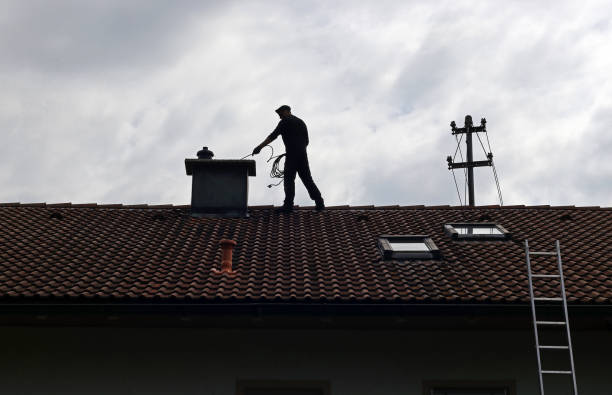Introduction
In order to keep a chimney system safe and functional, chimney sweeping is essential. Soot, creosote, and other debris that build up over time can be removed with regular cleaning. Understanding how frequently to sweep a chimney will help homeowners keep theirs in good working order and reduce the risk of chimney fires. In addition to offering tips for keeping a clean and functional chimney, this blog looks at the variables affecting the frequency of chimney sweeping.
Importance of Regular Chimney Sweeping
Creosote, a highly flammable substance that develops during the burning of wood, must not accumulate, so regular chimney sweeping is crucial. Chimney fires that are started by creosote deposits pose a serious risk to both property and people’s safety.
The removal of soot, leaves, and animal nests that obstruct the flue and prevent proper ventilation is another benefit of chimney sweeping. To prevent the buildup of dangerous gases like carbon monoxide in the living area, proper airflow is essential.
Factors Influencing the Frequency of Chimney Sweeping
The frequency of chimney sweeping is determined by a number of variables. These factors include the kind of fuel burned, the volume used, the effectiveness of the chimney, and the flue liner’s condition. Different fuel types, like wood, coal, and gas, produce different amounts of creosote and call for various cleaning schedules.
It may be necessary to sweep chimneys more frequently than others if they are used frequently during the colder months. The age and condition of the chimney should also be taken into consideration, as older chimneys may have damaged or deteriorated flue liners that call for more frequent cleaning.
Recommended Frequency for Chimney Sweeping
It is typically advised to have the chimney swept at least once a year to maintain a safe and effective chimney system. However, a number of variables can change this frequency. Let’s examine the suggested frequency for various fuel types:
· Wood-Burning Chimneys
It is advised to have chimneys that burn wood inspected and swept once a year or after 80 fires. Visual inspections performed on a regular basis throughout the year can also aid in spotting any indications of excessive creosote buildup or other problems that must be handled right away.
· Coal-Burning Chimneys
To avoid the buildup of soot and creosote, coal-burning chimneys should be inspected and cleaned at least twice a year. The need for more frequent cleaning is due to the higher carbon content and increased product of combustion associated with coal, which affects the chimney’s ability to perform at its best.
· Gas-Burning Chimneys
Less creosote is produced by gas appliance chimneys than by wood or coal-burning chimneys. However, a yearly inspection is still advised to look for any blockages or other problems that could prevent proper venting.
Signs Indicating the Need for Chimney Sweeping
While following the recommended cleaning schedule is crucial, it’s also critical to be alert to any symptoms that call for more urgent chimney sweeping. Some typical signs include:
- Excessive smoke when using the stove or fireplace.
- The fireplace is the source of the offensive smell.
- The accumulation of soot in the fireplace or on the nearby walls.
- A fire’s inability to start or be kept going.
- The chimney has debris or animals in it.
- The flue liner exhibits creosote or tar glaze.
DIY Chimney Sweeping vs. Professional Chimney Sweeping
While some homeowners might think about performing their own chimney sweeping, it is typically advised to hire a professional chimney sweep. Professional chimney sweeps are equipped with the skills, equipment, and knowledge necessary to thoroughly clean the chimney and spot any potential problems that may need fixing. For preserving the effectiveness and safety of the chimney, they can also offer insightful advice. DIY sweeping presents a risk. It might not find underlying issues or completely remove the accumulated creosote.
Benefits of Regular Chimney Sweeping
Regular chimney sweeping offers several advantages:
· Enhanced Safety
Chimney sweeping lowers the possibility of chimney fires and carbon monoxide poisoning by removing creosote and debris.
· Improved Efficiency
A clean chimney encourages better airflow and boosts the efficiency of the heating system, which improves heat output and lowers energy usage.
· Prolonged Chimney Lifespan
The lifespan of the chimney is increased by routine cleaning and maintenance, which helps prevent deterioration.
· Early Problem Detection
Professional chimney sweeps can spot potential problems before they become serious, enabling prompt repairs and avoiding expensive damage.
Safety Measures During Chimney Sweeping
Safety should always come first when cleaning a chimney. Following these crucial safety precautions will keep you safe:
- To protect yourself from soot and debris, wear protective equipment like goggles, gloves, and a dust mask.
- Ensure adequate ventilation to prevent the buildup of dangerous gases.
- To reduce mess and guard against harm to furniture or flooring, cover the area near the fireplace or stove with protective sheets.
- Make use of equipment and tools that are appropriate for chimney sweeping.
- If unsure or uneasy, speak to an experienced chimney sweep.
Chimney Sweeping Techniques
Professional chimney sweeps use a variety of methods to effectively clean chimneys. Typical techniques include:
· Rod & Brush
In order to dislodge and remove creosote and debris, this method involves scrubbing the inner walls of the chimney with flexible rods and brushes.
· Rotary Cleaning System
The interior of the chimney is thoroughly cleaned and tough deposits are removed using a motorized rotary brush.
· Power Sweeping
This method makes use of specialized machinery that combines brushes, rods, and strong vacuum suction to effectively remove creosote and debris.
· Chemical Cleaners
Creosote buildup may occasionally be dissolved by chemical cleaners, making it simpler to remove during sweeping.
Conclusion
Maintaining a safe and effective chimney system requires routine chimney sweeping. Homeowners can prolong the life of their chimneys while lowering the risk of chimney fires and other dangers by comprehending the variables influencing the frequency of chimney sweeping and following recommended guidelines. Always put safety first and seek the advice of a professional chimney sweep for thorough cleaning and inspections.





